Block and allow access to websites and specific URLs by adding them to an exception list. Using patterns containing keywords and wildcards, block and allow entire domains, subdomains, and parts of a domain. For example, msn.com, *.msn.com, msn.*, and *msn*.
Tip
After modifying any exception lists, you must click the Update Policies on All Clients button on the Action Bar to apply the changes to your clients.
Adding msn.com as an exception blocks or allows access to the entire msn.com website.
To allow Google searches, while blocking Google subdomains, do the following:
Allow google.com on your exception list.
Block *.google.com on your exception list.
This allows users to access google.com, but blocks them from accessing any Google sub-domains, such as mail.google.com and chat.google.com.
To block search results and URLs containing the keyword horror, block horror on your exception list. This blocks the following:
Web addresses like sites.google.com/site/horrorgames and horrorvideos.com
Search results for *horror*
There are many ways to use wildcards to filter content. Blocksi suggests that you experiment with different variations.
Create as many exception lists as you need.
To create an exception list
Click Content Filtering from the Main Menu and then click Filters from its sub-menu.
Click EXCEPTION LIST at the top of the screen. The Exception List screen appears.
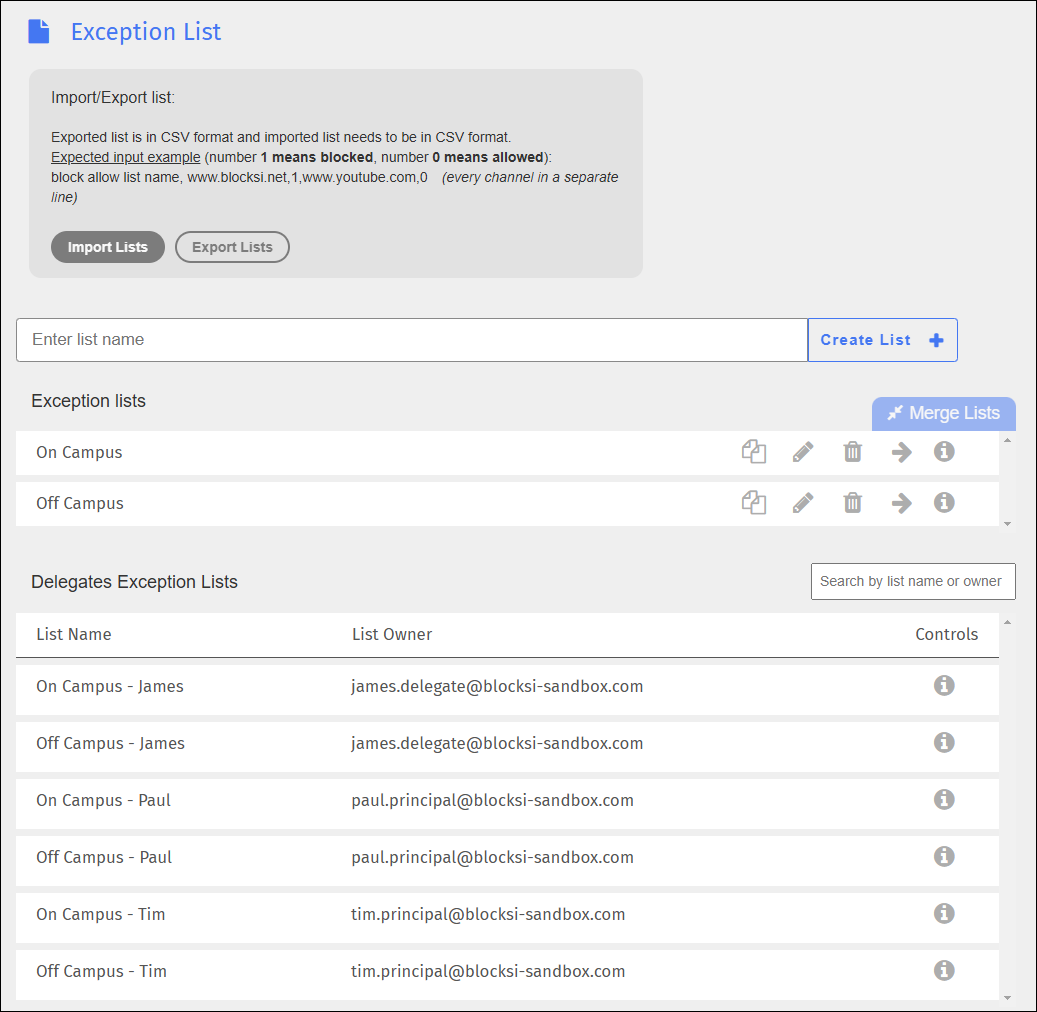
Type the name of the exception list in the Enter list name text field.
Click Create List +. The new list appears at the bottom of the list.
Click the
 icon. The Edit screen appears.
icon. The Edit screen appears.
Block and allow as many URLs as you need in an exception list.
To block and allow URLS in an exception list

Type a URL in the Enter URL text box. You are given the option to add a note to this URL entry.
Click the Block or Allow button.
Click Add to List + to add the URL. The URL you entered appears below. If you entered a note, it appears to the right of the URL entry.
Note
Click the Block or Allow button at any time to change a blocked URL to an allowed URL and vice versa. Click Update to block or allow the URL.
Note
Click the  icon to delete the URL from the list. A confirmation prompt appears. Click OK to delete the URL.
icon to delete the URL from the list. A confirmation prompt appears. Click OK to delete the URL.
Tip
Add URLs to the exception list from the Web Analytics screen. See Adding a URL to an Exception List for details.
Add URLs to exception lists directly from the Web Analytics screen.
To add a URL
Click Insights from the Main Menu and then click Web Analytics from its sub-menu. The Web Analytics screen appears.
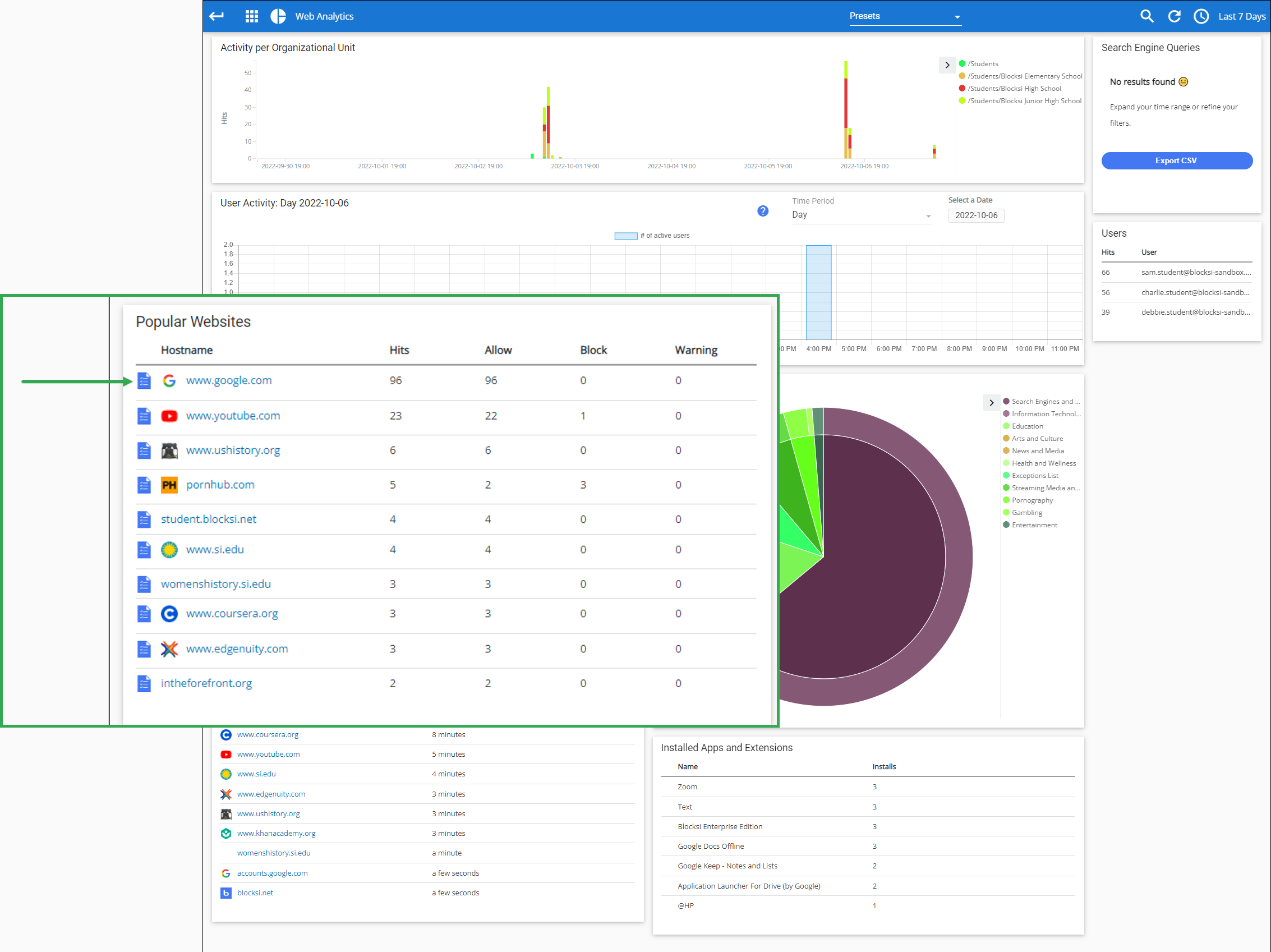
Click the blue document icon to the left of a website name in the Popular Websites section. The Add Website to an Exception List window opens.
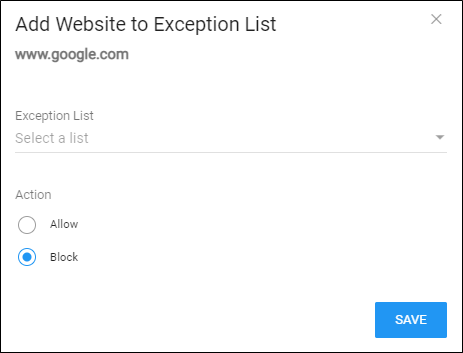
Select the desired list from the Exception List drop-down list.
Click Allow or Block to indicate whether to block or allow the website.
Click SAVE to add the website and close the window. Blocksi adds the website to the selected exception list.
The order in which the URLs appear in an exception list determine how the list functions. For example, if you add *x.com* to your exception list as a blocked URL and add *mobymax.com as an allowed URL, their order in the list affects how a student accesses the URLs. If you place *x.com* first in the list followed by *mobymax.com, then students who have a policy containing this exception list are not able to access mobymax.com. However, if you move *mobymax.com to the first position, then students are now able to access mobymax com.
To change the order of URLs in the list
Click a URL name and drag it into the desired position in the list.
Click the Save List Order button.
Edit a URL in an exception list.
To edit a URL in an exception list
Click Content Filtering from the Main Menu and then click Filters from its sub-menu.
Click EXCEPTION LIST at the top of the screen. The Exception List screen appears.
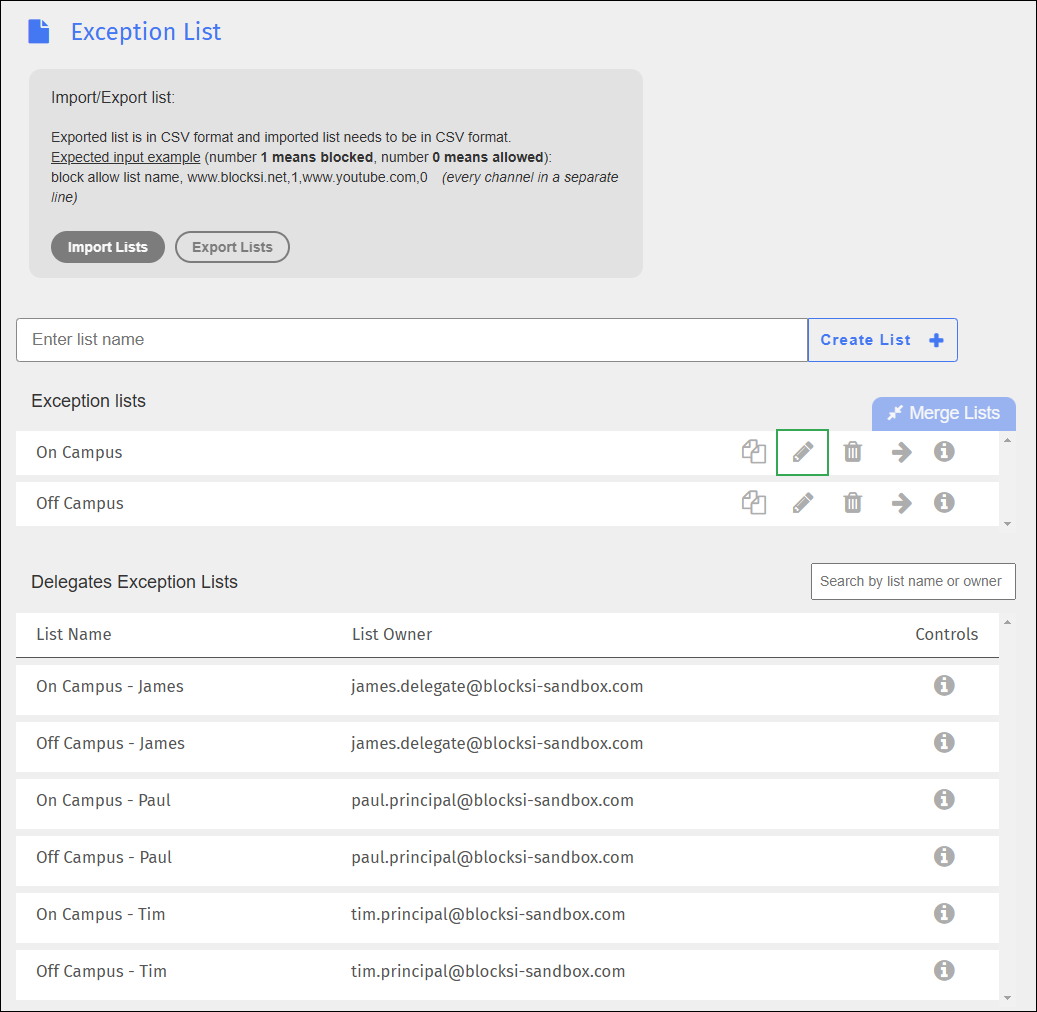
Look for the list that contains the URL to edit and click the
 icon. The Edit screen appears.
icon. The Edit screen appears.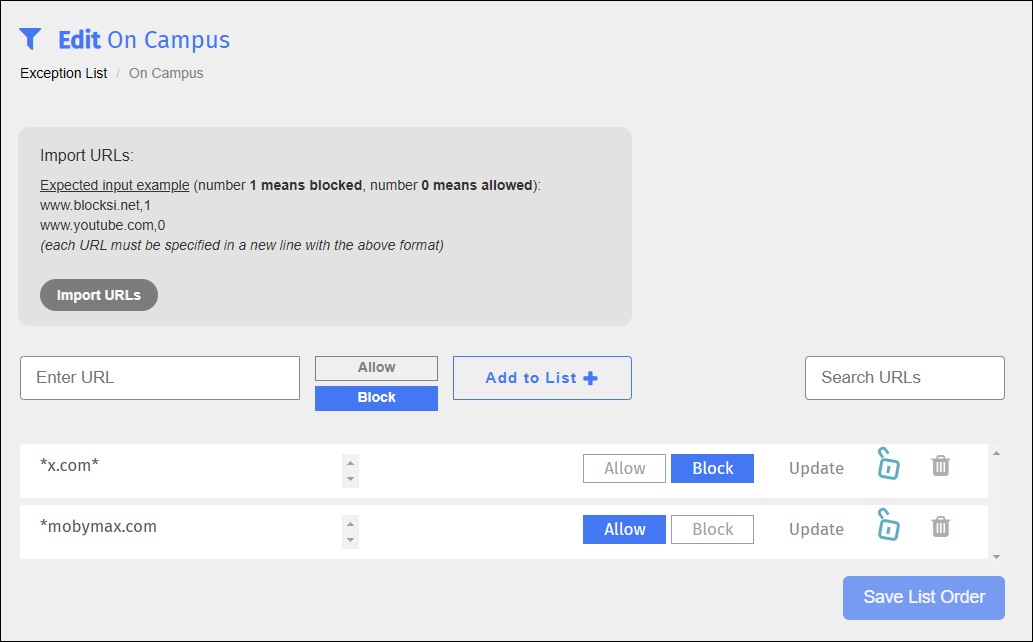
Click the name of the desired URL. A box opens to allow you to edit the URL.

Edit the URL and click the Save button.
Locking a URL prevents delegates from assigning to OUs any exception lists that contain this URL.
To lock a URL
Click Content Filtering from the Main Menu and then click Filters from its sub-menu.
Click EXCEPTION LIST at the top of the screen. The Exception List screen appears.

Look for the list that contains the URL to lock and click the
 icon. The Edit screen appears.
icon. The Edit screen appears.
Click the
 icon to the right of the desired URL.
icon to the right of the desired URL.
Delete a URL from an exception list when you no longer need it.
To delete a URL from an exception list
Click Content Filtering from the Main Menu and then click Filters from its sub-menu.
Click EXCEPTION LIST at the top of the screen. The Exception List screen appears.

Look for the list that contains the URL to delete and click the
 icon. The Edit screen appears.
icon. The Edit screen appears.
Click the
 icon to the right of the desired URL. A confirmation appears.
icon to the right of the desired URL. A confirmation appears.Click OK to delete the URL.
Search for URLs in an exception list.
To search for URLs
Click Content Filtering from the Main Menu and then click Filters from its sub-menu.
Click EXCEPTION LIST at the top of the screen. The Exception List screen appears.

Locate the name of the exception list to search, and click the
 icon to the right of the exception list name. The Edit screen appears.
icon to the right of the exception list name. The Edit screen appears.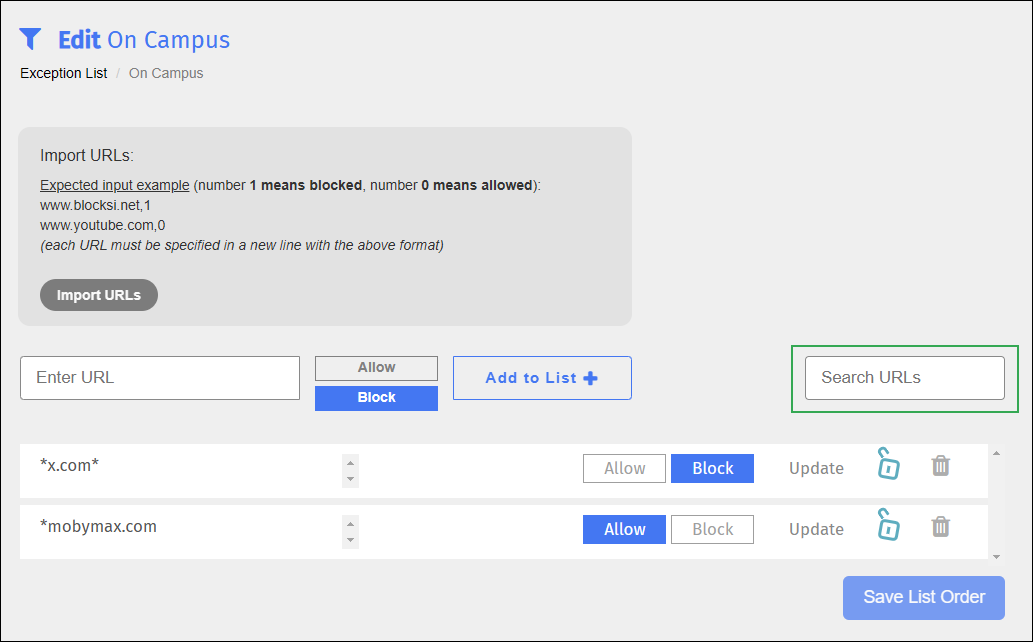
Type the URL in the Search URLs box. The URL appears as you type.
Rename an exception list as needed.
To rename an exception list
Click Content Filtering from the Main Menu and then click Filters from its sub-menu.
Click EXCEPTION LIST at the top of the screen. The Exception List screen appears.

Locate the list to rename, and click the list name. A box opens to allow you to rename the list. Note that Blocksi added Save and Cancel buttons to the right of the name, as shown below.

Rename the list, and click the Save button.
Modify an exception list as needed.
To modify an exception list
Click Content Filtering from the Main Menu and then click Filters from its sub-menu.
Click EXCEPTION LIST at the top of the screen. The Exception List screen appears.

Locate the name of the list to modify, and click the
 icon to the right of the list name. The Edit screen appears.
icon to the right of the list name. The Edit screen appears.
Make the necessary changes to the list.
Merge two or more exception lists into one new exception list.
To merge exception lists
Click Content Filtering from the Main Menu and then click Filters from its sub-menu.
Click EXCEPTION LIST at the top of the screen. The Exception List screen appears.

Click each one of the lists to merge. The lists you select turn blue.
Click Merge Lists. The New Merged List window opens.
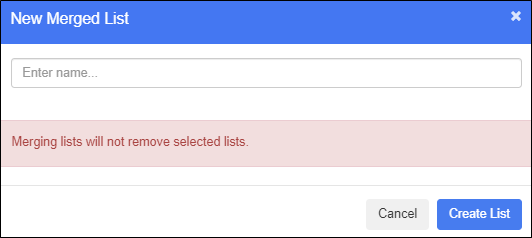
Type the name of the new list in the Enter name text box.
Click Create Filter to save the new list and close the window.
Use an existing exception list to create a new one.
To duplicate an exception list
Click Content Filtering from the Main Menu and then click Filters from its sub-menu.
Click EXCEPTION LIST at the top of the screen. The Exception List screen appears.
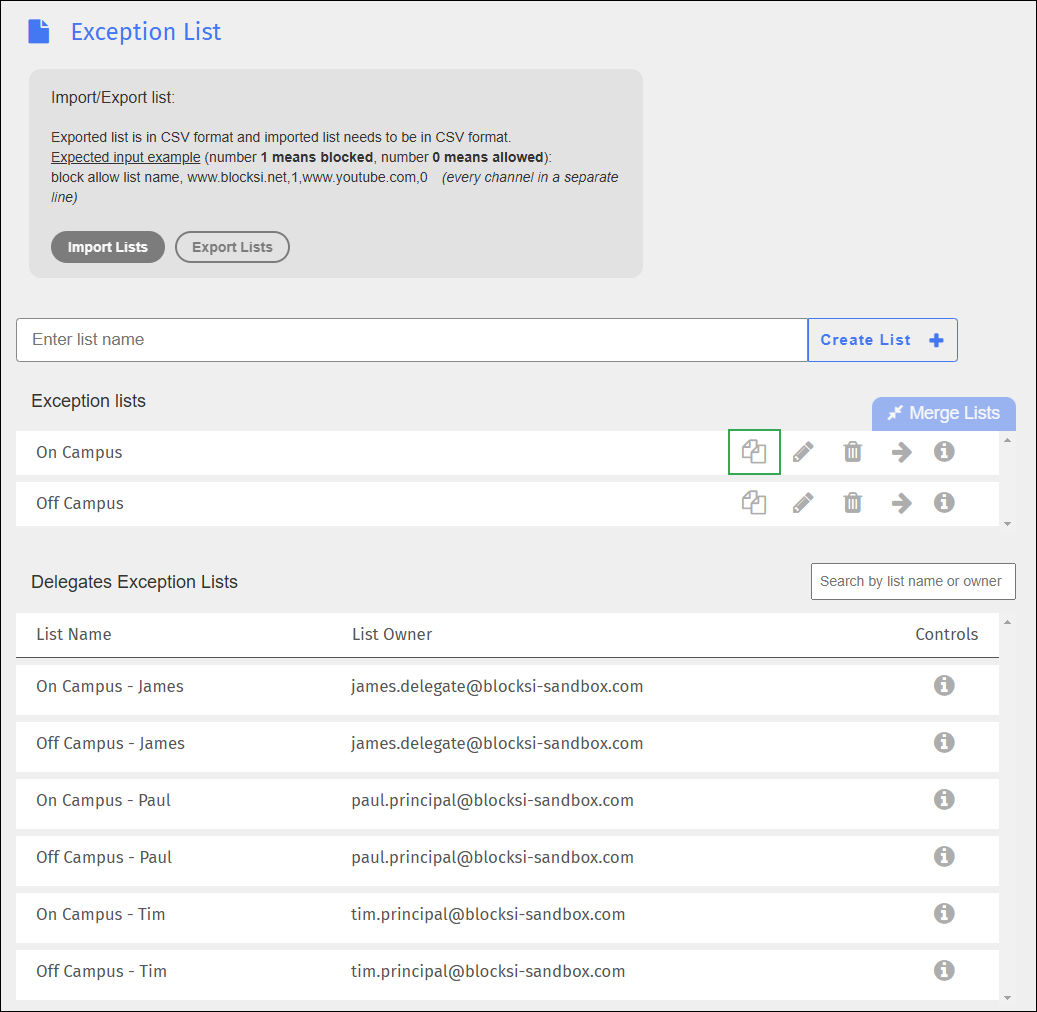
Locate the list to duplicate, and click the
 icon. The Duplicate List window opens.
icon. The Duplicate List window opens.
Type the name of the new list in the text box.
Click OK to add the list and close the window. The duplicated list appears at the bottom of the list. It contains the same URLs as the original list.
Make any desired changes to the new list and save it.
Import exception lists from an Excel or CSV file.
To import exception lists
Click Content Filtering from the Main Menu and then click Filters from its sub-menu.
Click EXCEPTION LIST at the top of the screen. The Exception List screen appears.
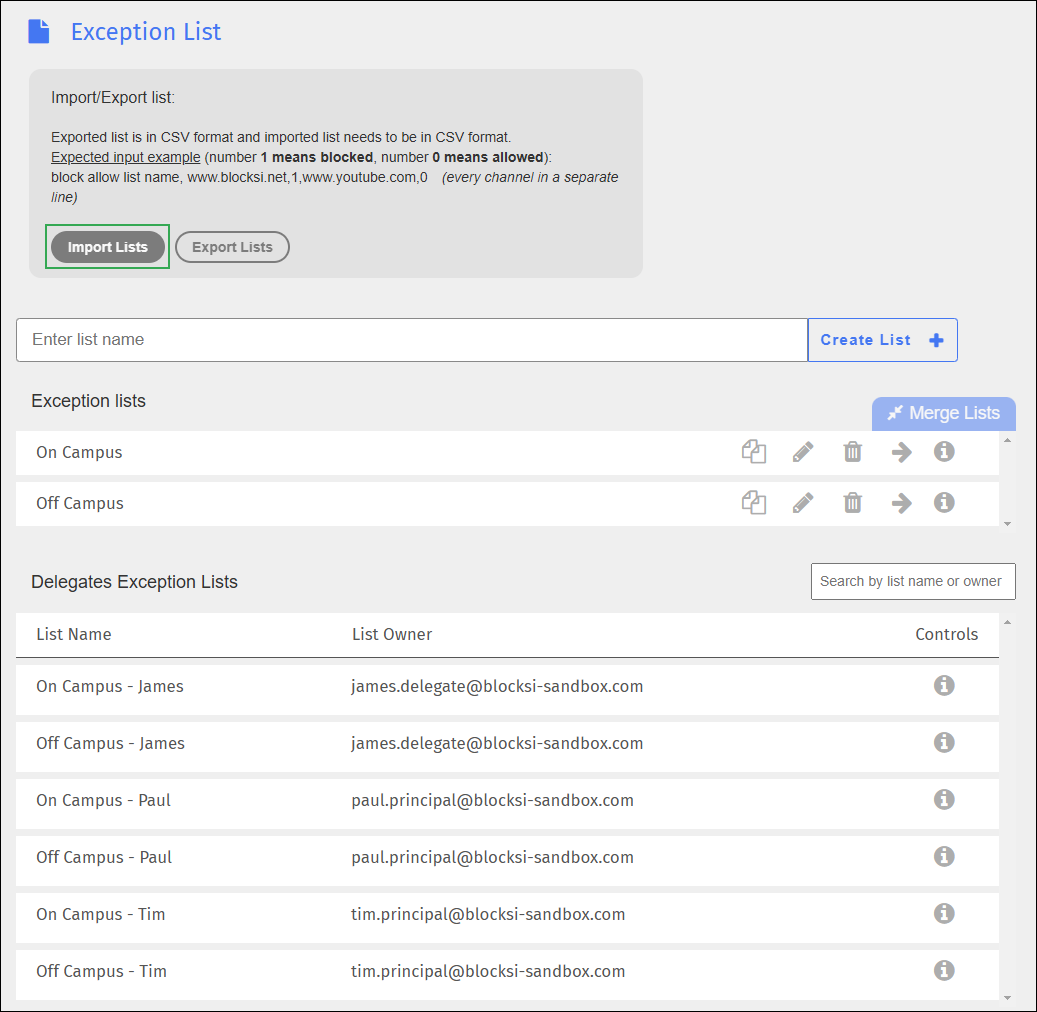
Click the Import Lists button to import the list. The Open dialog opens.
Navigate to the desired folder, select the file, and click Open. The lists are imported and appear at the bottom of the exception lists.
Important information about importing exception lists.
Importing Exception Lists From an Excel File
If you are importing exception lists from an Excel file, ensure that the Excel file appears as in the image below.
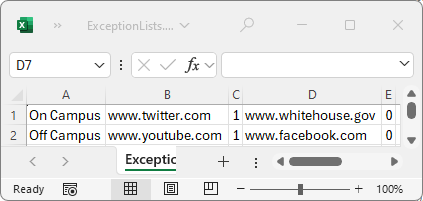
In the spreadsheet, blocked URLs are indicated by a 1; allowed URLs are represented by a 0. Note that the exception list name appears in Column A, the first website name appears in Column B, the Exception indicator appears in Column C, and so on. Also note that each exception list appears in a separate row.
Importing Exception Lists From a CSV File
If you are importing exception lists from a CSV file (for example, Notepad), ensure that the text file appears as in the image below.
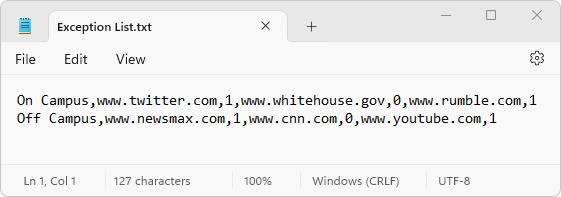
In the text file, blocked URLs are indicated by a 1; allowed URLs are represented by a 0. Note that the exception list name appears first, the first website name appears second, and the Exception indicator appears third, and so on, and all are separated by commas. Also note that each exception list appears on a separate line.
Import URLs into exception lists from an Excel or CSV file.
To import URLs into exception lists
Click Content Filtering from the Main Menu and then click Filters from its sub-menu.
Click EXCEPTION LIST at the top of the screen. The Exception List screen appears.

Look for the list to which to import URLs and click the
 icon. The Edit screen appears.
icon. The Edit screen appears.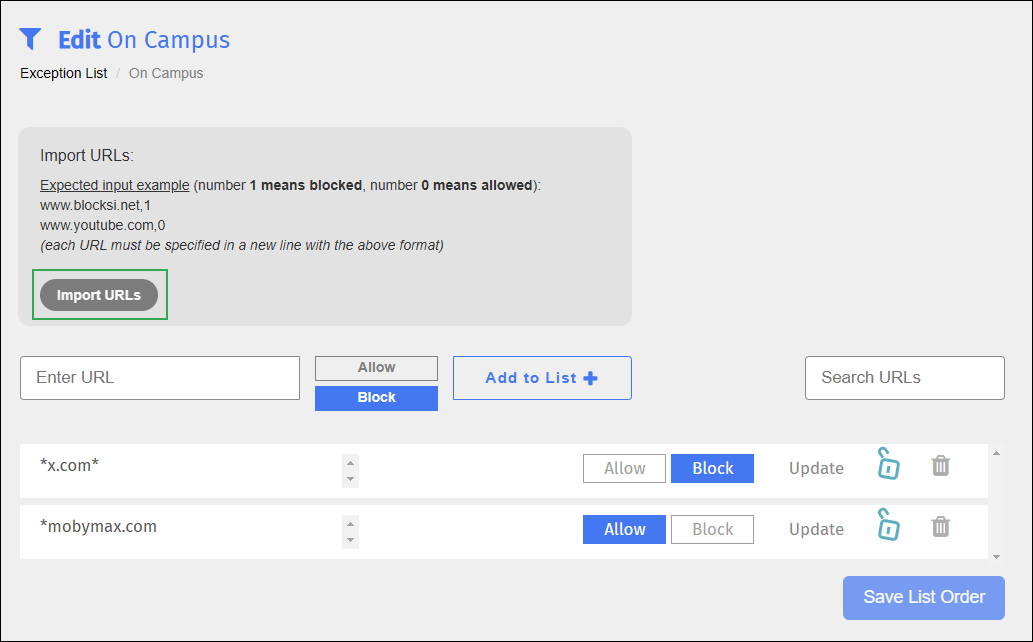
Click the Import URLs button to import the list. The Open dialog opens.
Navigate to the desired folder, select the file, and click Open. Blocksi imports the URLs and they appear at the bottom of the list of URLs.
Important information about importing URLs.
Importing URLs From an Excel File
If you are importing URLs from an Excel file, ensure that the Excel file appears as in the image below.
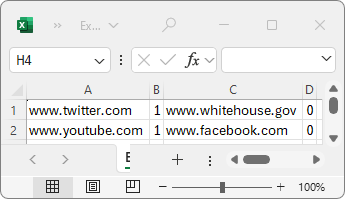
In the spreadsheet, Column A contains the domains and Column B contains a 1 or a 0 ( 1 means Blocked and 0 means allowed). Each new domain is added to the next row.
Importing URLs From a CSV File
If you are importing URLs from a CSV file (for example, Notepad), ensure that the text file appears as in the image below.
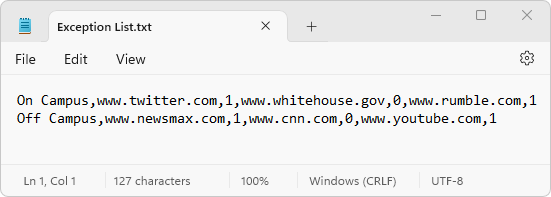
In the CSV file, the exception list name appears first, followed by the domain, which is followed by a comma and then either a 1 or a 0 ( 1 means Blocked and 0 means Allowed). Also note that each domain appears on a separate line.
Export exception lists individually or in single file to keep for your records.
To export exception lists
Click Content Filtering from the Main Menu and then click Filters from its sub-menu.
Click EXCEPTION LIST at the top of the screen. The Exception List screen appears.
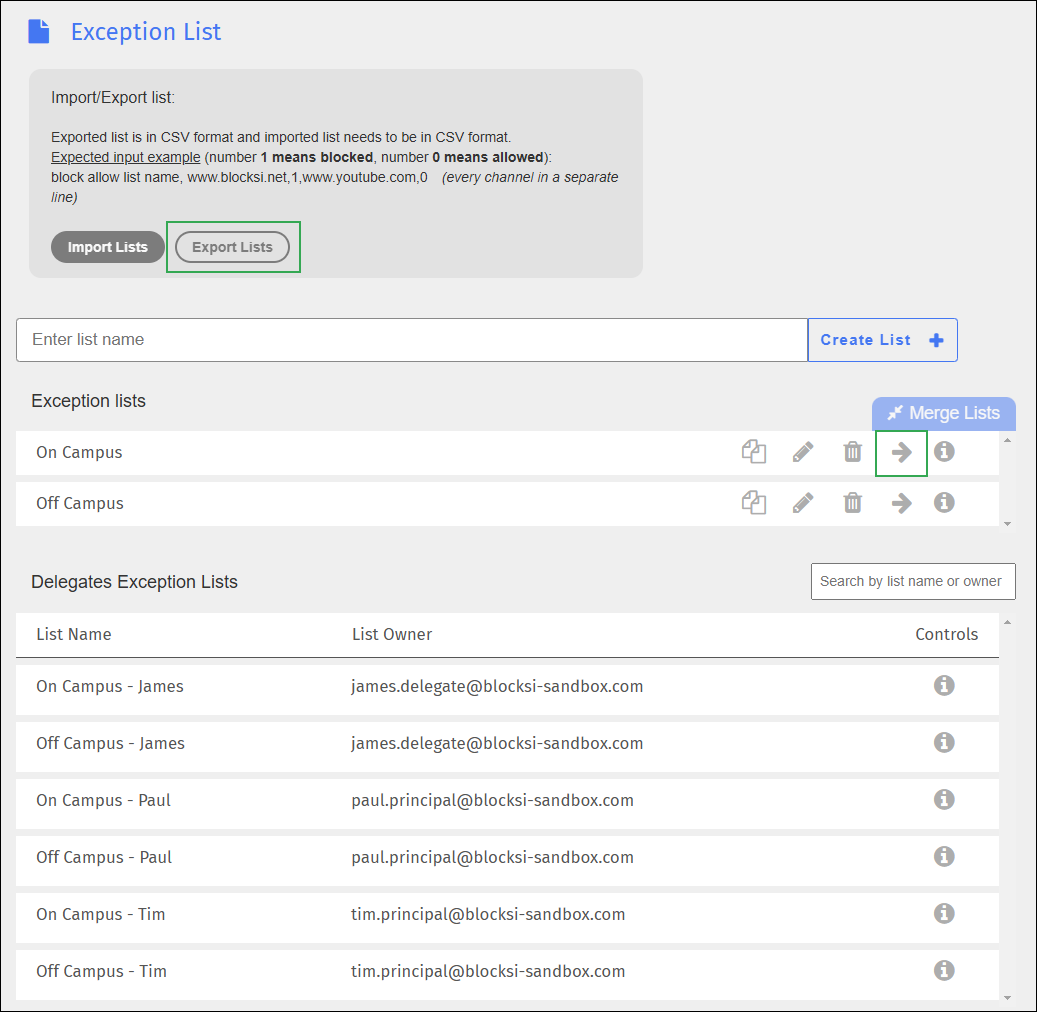
Do one of the following:
To export an individual list to a single file, click the
 icon. The file appears in the lower left-hand corner of your screen in your spreadsheet program. Click it to open and save it.
icon. The file appears in the lower left-hand corner of your screen in your spreadsheet program. Click it to open and save it.To export all lists to a single file, click the Export Lists button. The file appears in the lower left-hand corner of your screen in your spreadsheet program. Click it to open and save it.
The following is an image showing an example of exported exception lists.

Note
In the spreadsheet, blocked URLs are indicated by a 1; allowed URLs are represented by a 0. Note that the exception list name appears in Column A, the first website name appears in Column B, the Exception indicator appears in Column C, and so on. Also note that each exception list appears in a separate row.
Delete exception lists when you no longer need them.
To delete an exception list
Click Content Filtering from the Main Menu and then click Filters from its sub-menu.
Click EXCEPTION LIST at the top of the screen. The Exception List screen appears.
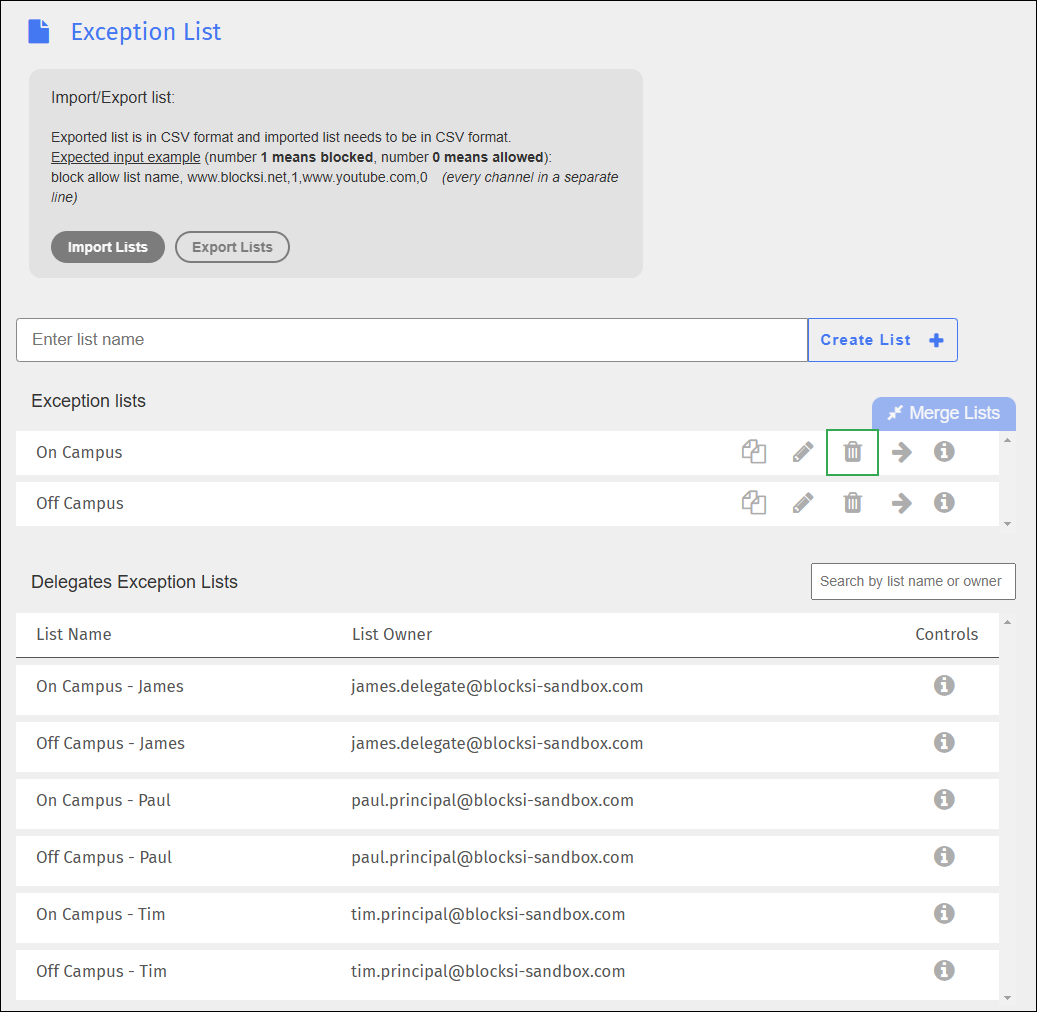
Locate the list to delete, and click the
 icon to the right of the list. A confirmation prompt appears.
icon to the right of the list. A confirmation prompt appears.Click OK to delete the list and close the prompt.